Charles E W Bean, Diaries, AWM38 3DRL 606/270 PART 1/1 - 1918 - 1939 - Part 4
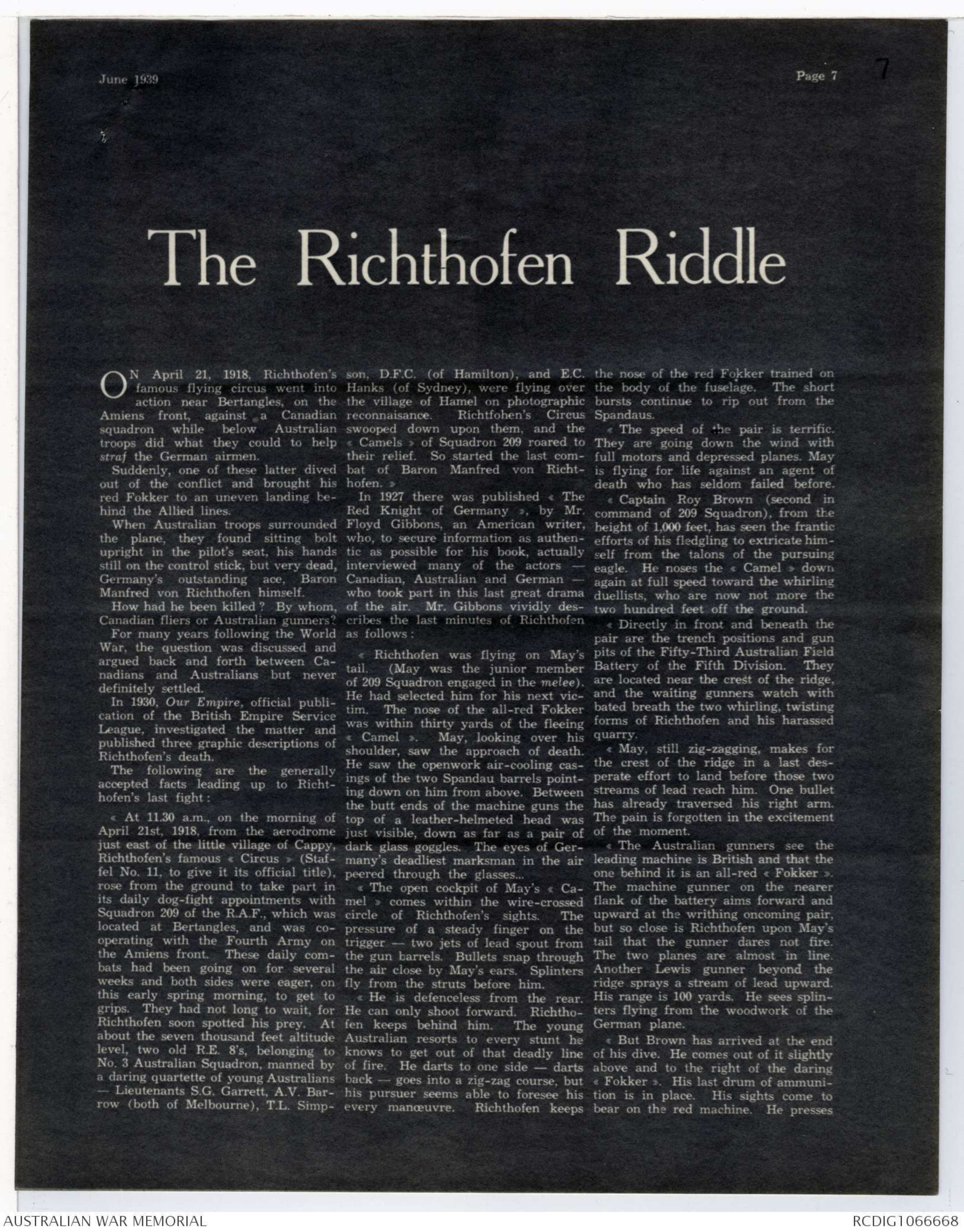
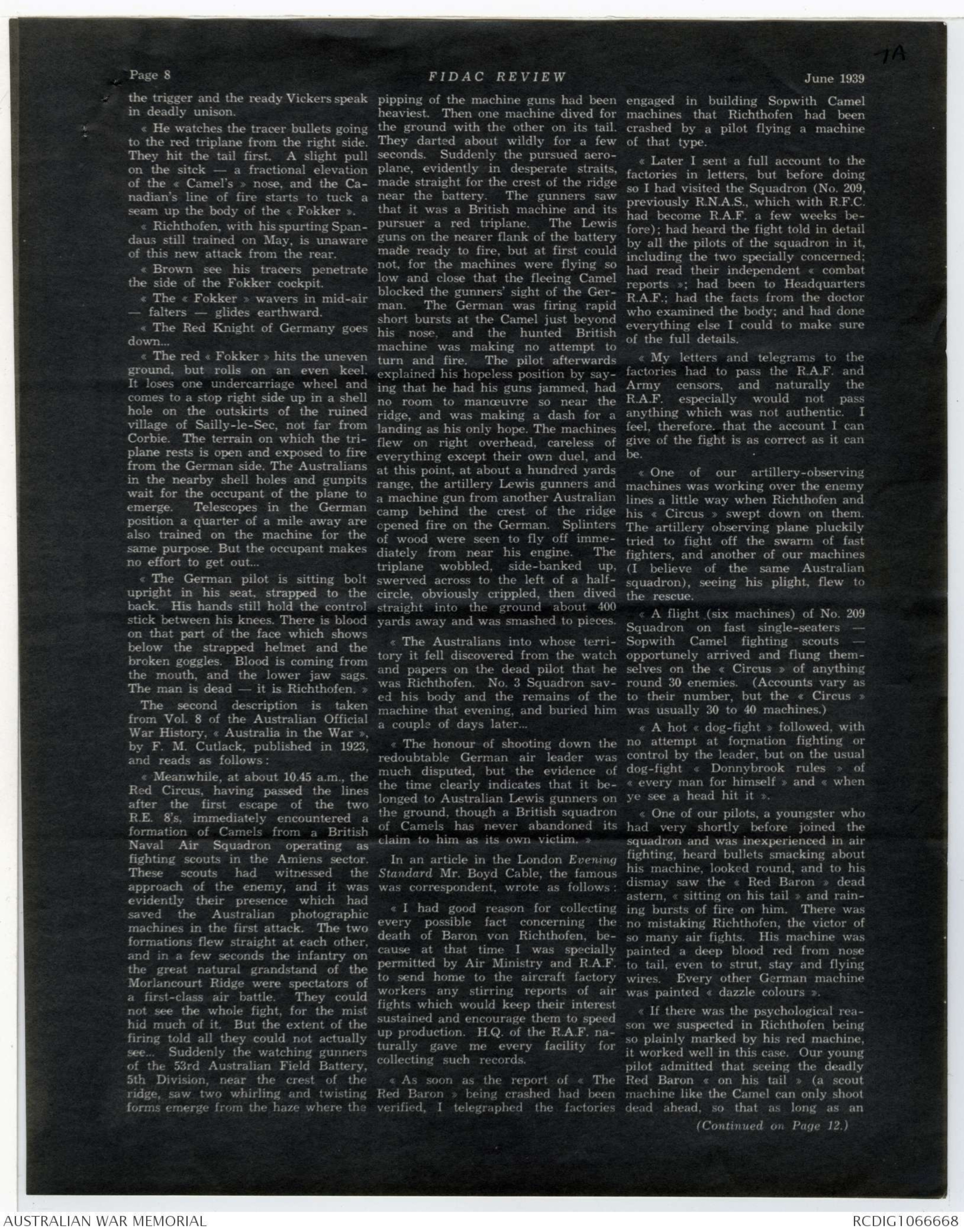
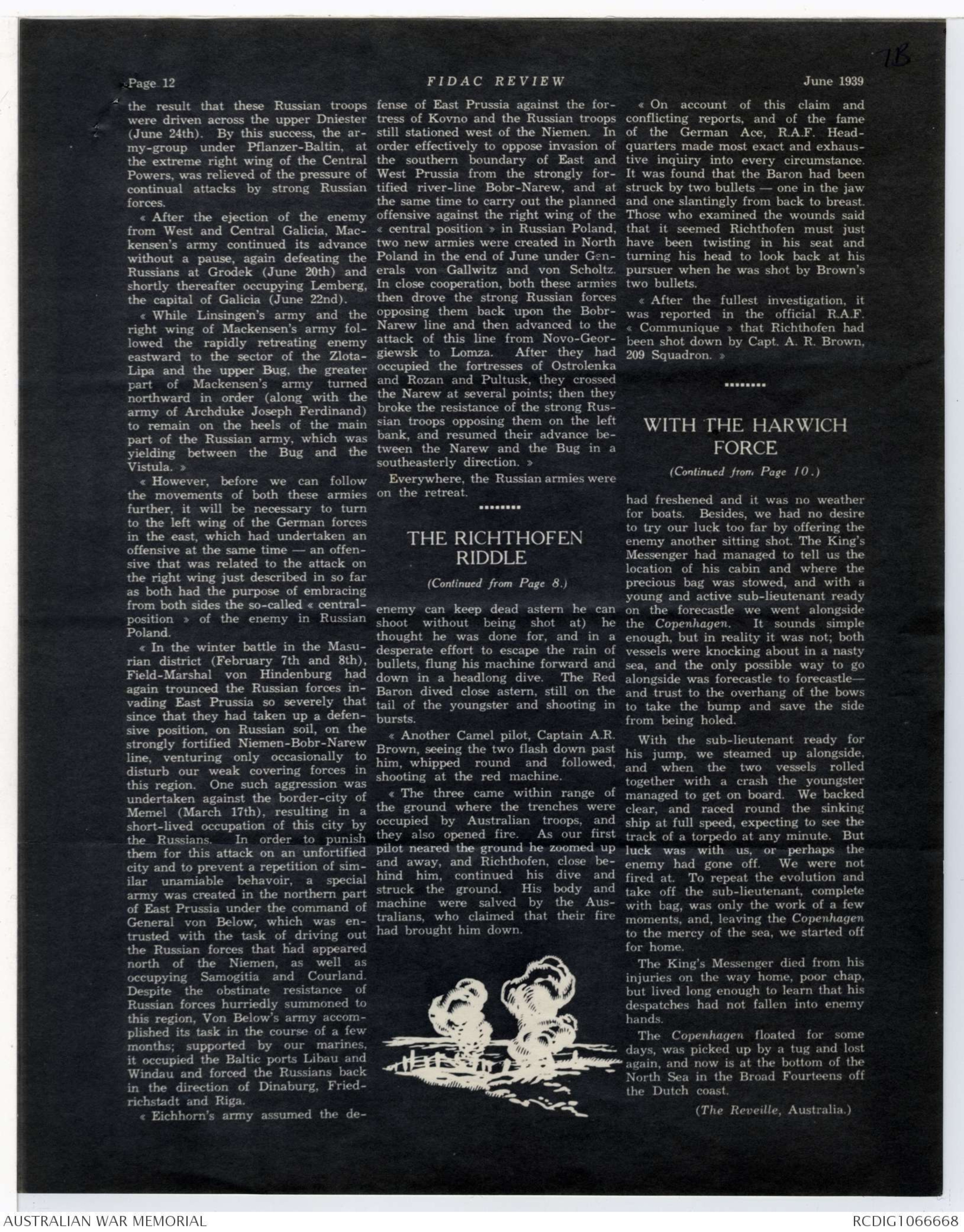
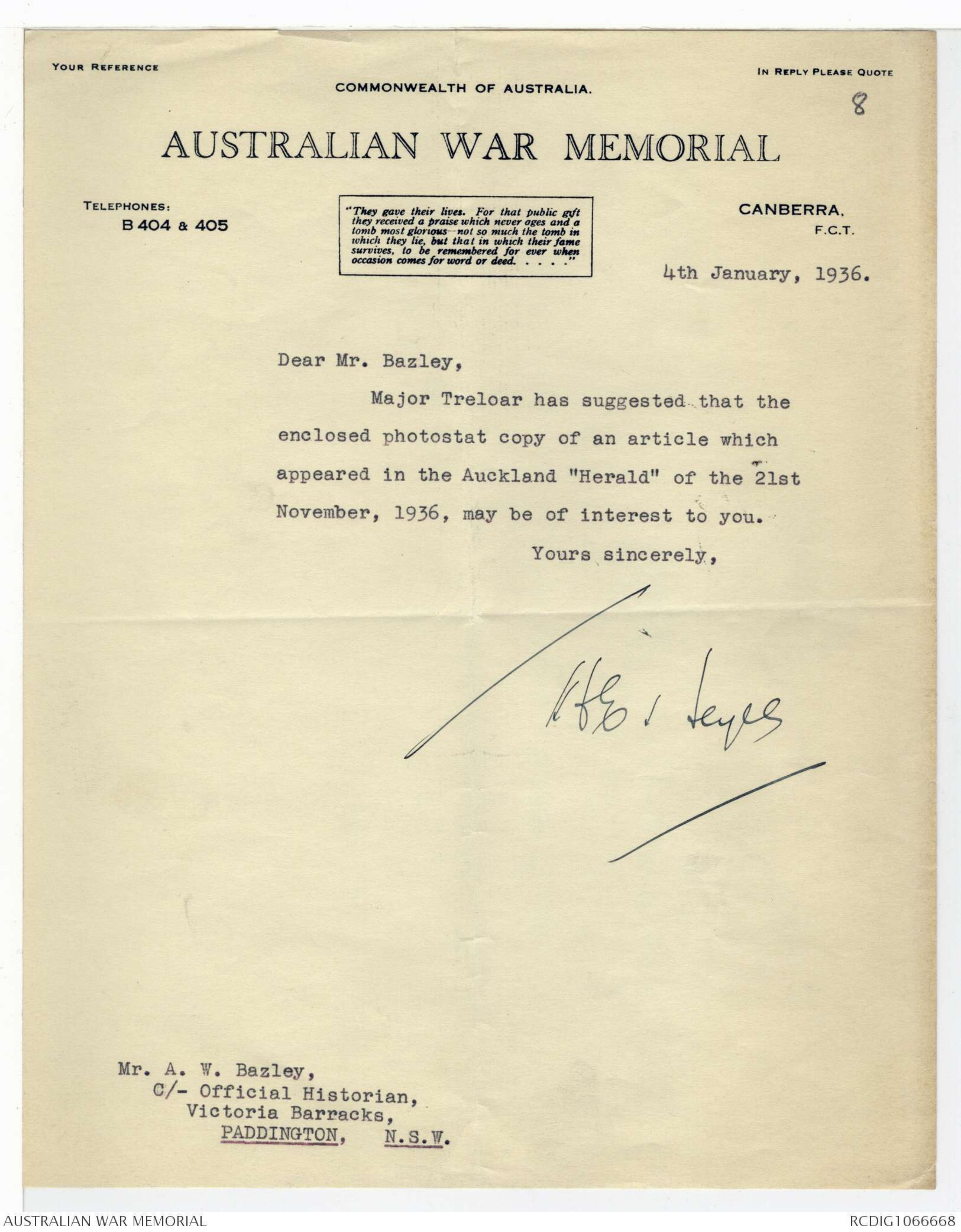

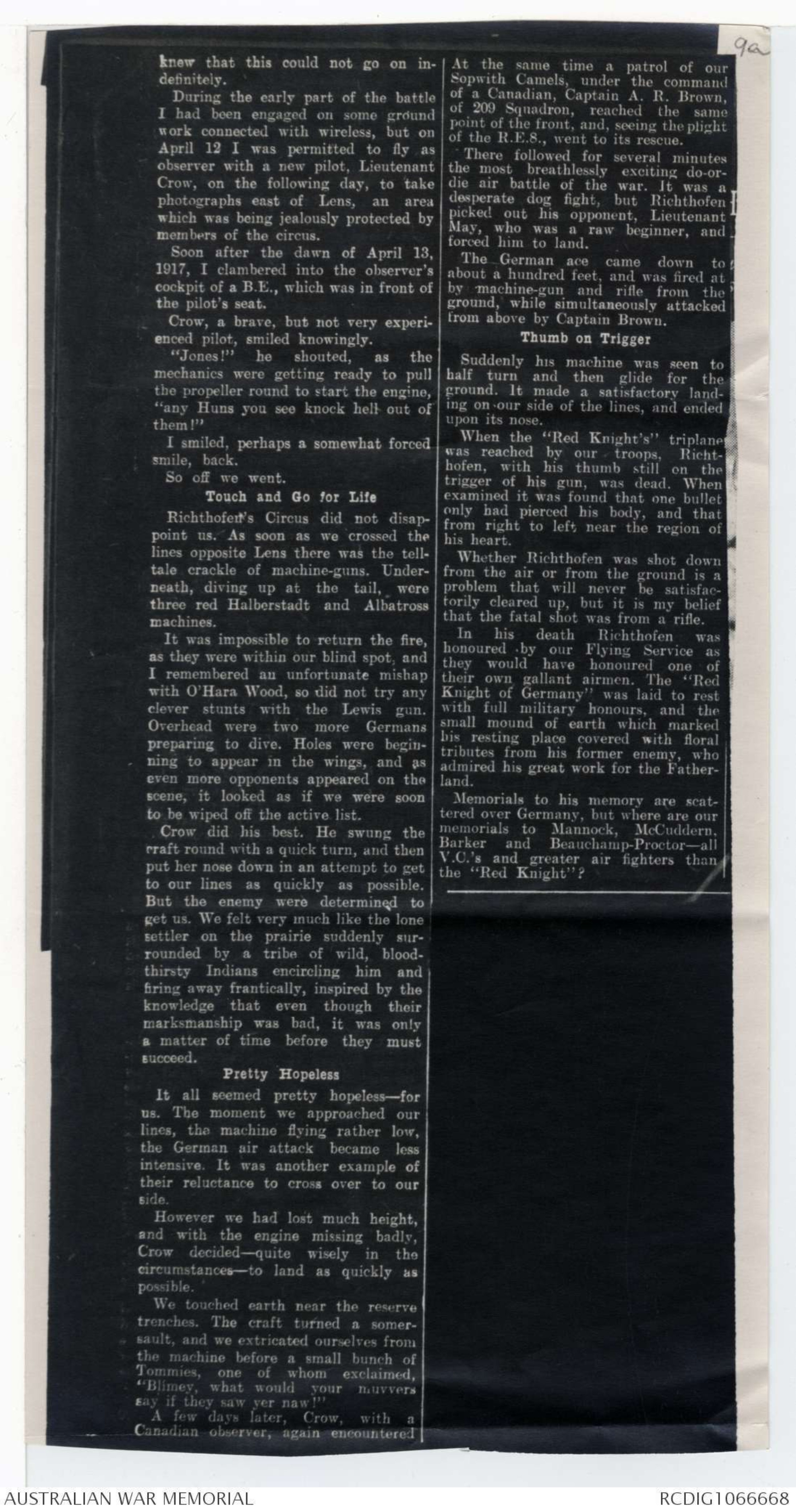

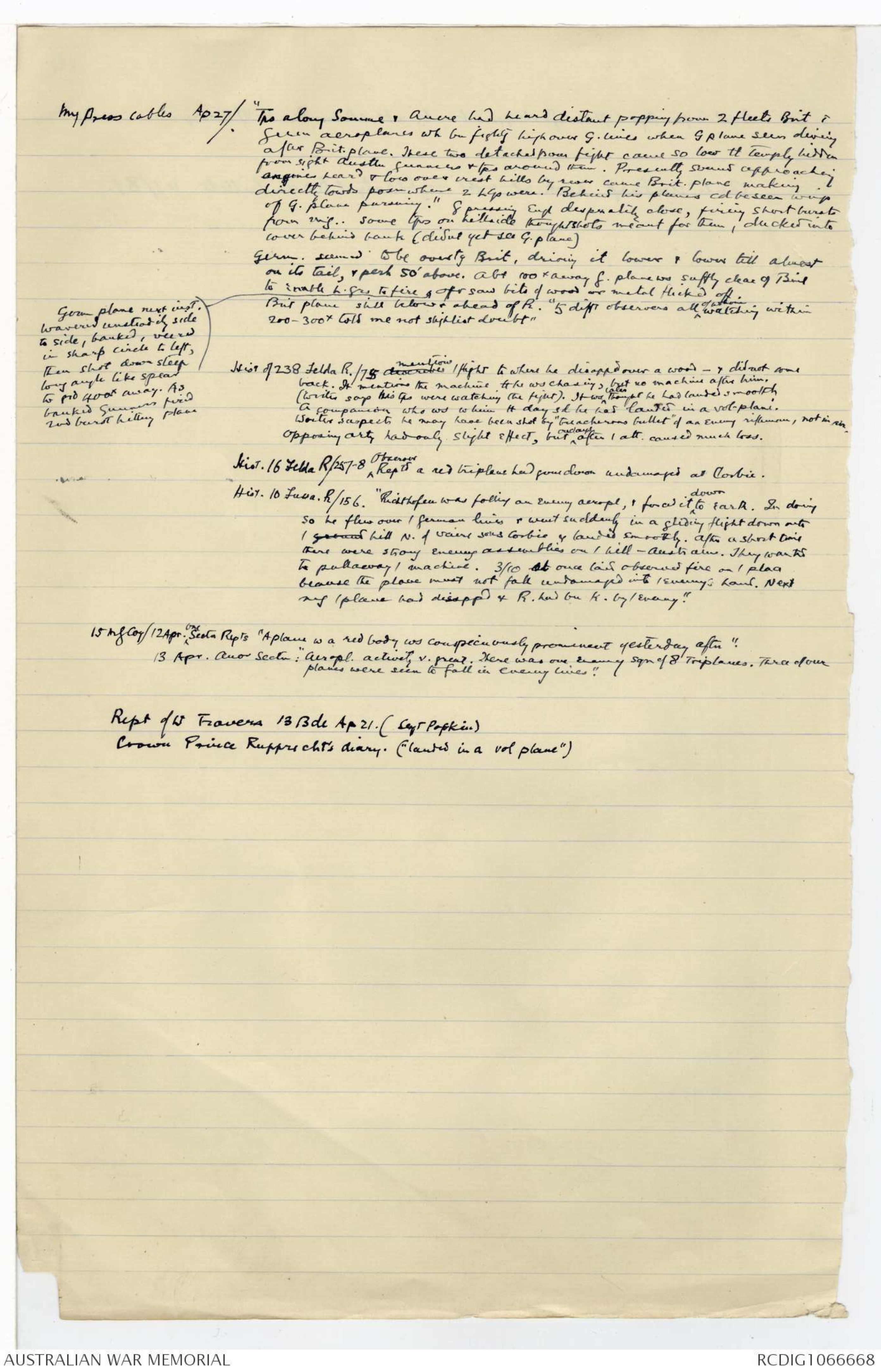
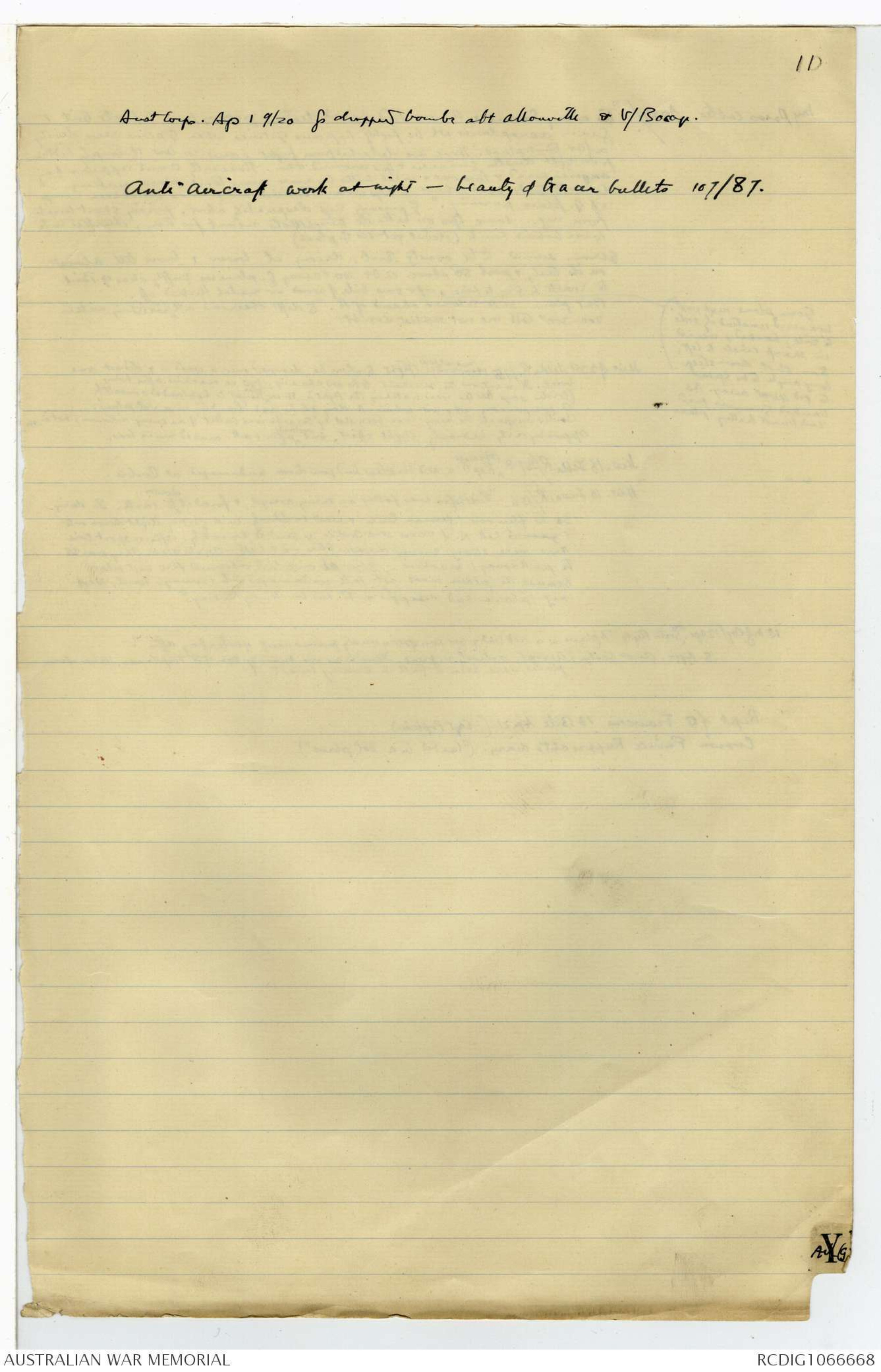

June 1939
Page 7
The Richthofen Riddle
ON April 21, 1918, Richthofen's
famous flying circus went into
action near Bertangles, on the
Amiens front, against a Canadian
squadron while below Australian
troops did what they could to help
straf the German airmen.
Suddenly, one of these latter dived
out of the conflict and brought his
red Fokker to an uneven landing behind
the Allied lines.
When Australian troops surrounded
the plane, they found sitting bolt
upright in the pilot's seat, his hands
still on the control stick, but very dead,
Germany's outstanding ace, Baron
Manfred von Richthofen himself.
How had he been killed ? By whom,
Canadian fliers or Australian gunners?
For many years following the World
War, the question was discussed and
argued back and forth between Canadians
and Australians but never
definitely settled.
In 1930, Our Empire, official publication
of the British Empire Service
League, investigated the matter and
published three graphic descriptions of
Richthofen's death.
The following are the generally
accepted facts leading up to Richthofen's
last fight:
<At 11:30 a.m., on the morning of
April 21st, 1918, from the aerodrome
just east of the little village of Cappy,
Richthofen's famous <Circus> (Staffel
No. 11, to give it its official title),
rose from the ground to take part in
its daily dog-fight appointments with
Squadron 209 if the R.A.F., which was
located at Bertangles, and was cooperating
with the Fourth Army on
the Amiens front. These daily combats
had been going on for several
weeks and both sides were eager, on
this early spring morning, to get to
grips. They hand not long to wait, for
Richthofen soon spotted his prey. At
about the seven thousand feet altitude
level, two old R.E. 8's, belonging to
No. 3 Australian Squadron, manned by
a daring quartette of young Australians
— Lieutenants S.G. Garrett, A.V. Barrow
(both of Melbourne), T.L. Simpson,
D.F.C. (of Hamilton). and E.C.
Hanks (of Sydney), were flying over
the village of Hamel on photographic
reconnaisance. Richtfohen's Circus
swooped down upon them, and the
<Camels> of Squadron 209 roared to
their relief. So started the last combat
of Baron Manfred von Richthofen>
In 1927 there was published <The
Red Knight of Germany>, by Mr.
Floyd Gibbons, and American writer,
who, to secure information as authentic
as possible for his book, actually
interviewed many of the actors -
Canadian, Australian and German -
who took part in this last great drama
of the air. Mr. Gibbons vividly describes
the last minutes of Richthofen
as follows:
<Richthofen was flying on May's
tail. (May was the junior member
of 209 Squadron engaged in the melee).
He had selected him for his next victim.
The nose of the all-red Fokker
was within thirty yards of the fleeing
<Camel>. May, looking over his
shoulder, saw the approach of death.
He saw the openwork air-cooling casings
of the two Spandau barrels pointing
down on him from above. Between
the butt ends of the machine guns the
top of a leather-helmeted head was
just visible, down as far as a pair of
dark glass goggles. The eyes of Germany's
deadliest marksman in the air
peered through the glasses...
<The open cockpit of May's <Camel>
comes within the wire-crossed
circle of Richthofen's sights. The
pressure of a steady finger on the
trigger — two jets of lead spout from
the gun barrels. Bullets snap through
the air close by May's ears. Splinters
fly from the struts before him.
<He is defenceless from the rear.
He can only shoot forward. Richthofen
keeps behind him. The young
Australian resorts to every stunt he
knows to get out of that deadly line
of fire. He darts to one side — darts
back — goes into a zig-zag course, but
his pursuer seems able to foresee his
every manoevre. Richthofen keeps
the nose of the red Fokker trained on
the body of the fuselage. The short
bursts continue to rip out from the
Spandaus.
<The speed of the pair is terrific.
They are going down the wind with
full motors and depressed planes. May
is flying for life against an agent of
death who has seldom failed before.
<Captain Roy Brown (second in
command of 209 Squadron), from the
height of 1,000 feet, has seen the frantic
efforts of his fledgling to extricate himself
from the talons of the pursuing
eagle. He noses the <Camel> down
again at full speed toward the whirling
duellists, who are now not more the
two hundred feet off the ground.
<Directly in front and beneath the
pair are the trench positions and gun
pits of the Fifty-Third Australian Field
Battery of the Fifth Division. They
are located near the crest of the ridge,
and the waiting gunners watch with
bated breath the two whirling, twisting
forms of Richthofen and his harassed
quarry.
<May, still zig-zagging, makes for
the crest of the ridge in a last desperate
effort to land before those two
streams of lead reach him. One bullet
has already traversed his right arm.
The pain is forgotten in the excitement
of the moment.
<The Australian gunners see the
leading machine is British and that the
one behind it is an all-red <Fokker>.
The machine gunner on the nearer
flank of the battery aims forward and
upward at the writhing oncoming pair,
but so close is Richthofen upon May's
tail that the gunner dares not fire.
The two planes are almost in line.
Another Lewis gunner beyond the
ridge sprays a stream of lead upward.
His range is 100 years. He sees splinters
flying from the woodwork of the
German plane.
<But Brown has arrived at the end
of his dive. He comes out of it slightly
above and to the right of the daring
<Fokker>. His last drum of ammunition
is in place. His sights come to
bear on the red machine. He presses
Page 8
FIDAC REVIEW
June 1939
the trigger and the ready Vickers speak
in deadly unison.
<He watches the tracer bullets going
to the red triplane from the right side.
They hit the tail first. A slight pull
on the sitck — a fractional elevation
of the <Camel's> nose, and the Canadian's
line of fire starts to tuck a
seam up the body of the <Fokker>.
<Richthofen, with his spurting Spandaus
still trained on May, is unaware
of this new attack from the rear.
<Brown see his tracers penetrate
the side of the Fokker cockpit.
<The <Fokker> wavers in mid-air
— falters — glides earthward.
<The Red Knight of Germany goes
down...
<The red <Fokker> hits the uneven
ground, but rolls on an even keel.
It loses one undercarriage wheel and
comes to a stop right side up in a shell
hole on the outskirts of the ruined
village of Sailly-le-Sec, not far from
Corbie. The terrain on which the triplane
rests is open and exposed to fire
from the German side. The Australian
in the nearby shell holes and gunpits
wait for the occupant of the plane to
emerge. Telescopes in the German
position a quarter of a mile away are
also trained on the machine for the
same purpose. But the occupant makes
no effort to get out...
<The German pilot is sitting bolt
upright in his seat, strapped to the
back. His hands still hold the control
stick between his knees. There is blood
on that part of the face which shows
below the strapped helmet and the
broken goggles. Blood is coming from
the mouth, and the lower jaw sags.
The man is dead — it is Richthofen.>
The second description is taken
from Vol. 8 of the Australian Official
War History, <Australia in the War>,
by F. M. Cutlack, published in 1923,
and reads as follows:
<Meanwhile, at about 10.45 a.m., the
Red Circus, having passed the lines
after the first escape of the two
R.E. 8's, immediately encountered a
formation of Camels from a British
Naval Air Squadron operating as
fighting scouts in the Amiens sector.
These scouts had witnessed the
approach of the enemy, and it was
evidently their presence which had
saved the Australian photographic
machines in the first attack. The two
formations flew straight at each other,
and in a few seconds the infantry on
the great natural grandstand of the
Morlancourt Ridge were spectators of
a first-class air battle. They could
not see the whole fight, for the mist
hid much of it. But the extent of the
firing told all they could not actually
see... Suddenly the watching gunners
of the 53rd Australian Field Battery,
5th Division, near the crest of the
ridge, saw two whirling and twisting
forms emerge from the haze where the
pipping of the machine guns had been
heaviest. Then one machine dived for
the ground with the other on its tail.
They darted about wildly for a few
seconds. Suddenly the pursued aeroplane,
evidently in desperate straits,
made straight for the crest of the ridge
near the battery. The gunners saw
that it was a British machine and its
pursuer a red triplane. The Lewis
guns on the nearer flank of the battery
made ready to fire, but at first could
not, for the machines were flying so
low and close that the fleeing Camel
blocked the gunners' sight of the German.
The German was firing rapid
short bursts at the Camel just beyond
his nose, and the hunted British
machine was making no attempt to
turn and fire. The pilot afterwards
explained his hopeless position by saying
that he had his guns jammed, had
no room to manoeuvre so near the
ridge, and was making a dash for a
landing as his only hope. The machines
flew in right overhead, careless of
everything except their own duel, and
at this point, at about a hundred yards
range, the artillery Lewis gunners and
a machine gun from another Australian
camp behind the crest of the ridge
opened fire on the German. Splinters
of wood were seen to fly off immediately
from near his engine. The
triplane wobbled, side-banked up,
swerved across to the left of a half-circle,
obviously crippled, then dived
straight into the ground about 400
yards away and was smashed to pieces.
<The Australians into whose territory
it fell discovered from the watch
and papers on the dead pilot that he
was Richthofen. No. 3 Squadron saved
his body and the remains of the
machine that evening, and buried him
a couple of days later...
<The honour of shooting down the
redoubtable German air leader was
much disputed, but the evidence of
the time clearly indicates that it belonged
to Australian Lewis gunners on
the ground, though a British squadron
of Camels has never abandoned its
claim to him as its own victim.>
In an article in the London Evening
Standard Mr. Boyd Cable, the famous
was correspondent, wrote as follows:
<I had good reason for collecting
every possible fact concerning the
death of Baron von Richthofen, because
at that time I was specially
permitted by Air Ministry and R.A.F.
to send home to the aircraft factory
workers any stirring reports of air
fights which would keep their interest
sustained and encourage them to speed
up production. H.Q. of the R.A.F naturally
gave me every facility for
collecting such records.
<As soon as the report of <The
Red Baron> being crashed had been
verified, I telegraphed the factories
engaged in building Sopwith Camel
machines that Richthofen had been
crashed by a pilot flying a machine
of that type.
<Later I sent a full account to the
factories in letters, but before doing
so I had visited the Squadron (No. 209,
previously R.N.A.S., which with R.F.C.
had become R.A.F. a few weeks before);
had heard the fight told in detail
by all the pilots of the squadron in it,
including the two specially concerned;
had read their independent <combat
reports >; had been sent to Headquarters
R.A.F.; had the facts from the doctor
who examined the body; and had done
everything else I could to make sure
of the full details.
<My letters and telegrams to the
factories had to pass the R.A.F. and
Army censors, and naturally the
R.A.F. especially would not pass
anything which was not authentic. I
feel, therefore, that the account I can
give of the fight is as correct as it can
be.
<One of our artillery-observing
machines was working over the enemy
lines a little way when Richthofen and
his <Circus> swept down on them.
The artillery observing plane pluckily
tried to fight off the swarm of fast
fighters, and another of our machines
(I believe of the same Australian
squadron), seeing his plight, flew to
the rescue.
<A flight (six machines) of No. 209
Squadron on fast single-seaters —
Sopwith Camel fighting scouts —
opportunely arrived and flung themselves
on the <Circus> of anything
round 30 enemies. (Accounts vary as
to their number, but the <Circus>
was usually 30 to 40 machines.)
<A hot <dog-fight> followed, with
no attempt at formation fighting or
control by the leader, but on the usual
dog-fight <Donnybrook rules> of
<every man for himself> and <when
ye see a head hit it>.
<One of our pilots, a youngster who
had very shortly before joined the
squadron and was inexperienced in air
fighting, heard bullets smacking about
his machine, looked round, and to his
dismay saw the <Red Baron> dead
astern, <sitting on his tail> and raining
bursts of fire on him. There was
no mistaking Richthofen, the victor of
so many air fights. His machine was
painted a deep blood red from nose
to tail, even to strut, stay and flying
wires. Every other German machine
was painted <dazzle colours>.
<If there was the psychological reason
we suspected in Richthofen being
so plainly marked by his red machine,
it worked well in this case. Our young
pilot admitted that seeing the deadly
Red Baron <on his tail> (a scout
machine like the Camel can only shoot
dead ahead, so that as long as an
(Continued on Page 12.)
Page 12
FIDAC REVIEW
June 1939
the result that these Russian troops
were driven across the upper Dniester
(June 24th). By this success, the army-group
under Pflanzer-Baltin, at
the extreme right wing of the Central
Powers, was relieved of the pressure of
continual attacks by strong Russian
forces.
<After the ejection of the enemy
from West and Central Galicia, Mackensen's
army continued its advance
without a pause, again defeating the
Russians at Grodek (June 20th) and
shortly thereafter occupying Lemberg,
the capital of Galicia (June 22nd).
<While Linsingen's army followed the
rapidly retreating enemy
eastward to the sector of the Zlota-Lipa
and the upper Bug, the greater
part of Mackensen's army turned
northward in order (along with the
army of Archduke Joseph Ferdinand)
to remain on the heels of the main
part of the Russian army, which was
yielding between the Bug and the Vistula.>
<However, before we can follow
the movements of both these armies
further, it will be necessary to turn
to the left wing of the German forces
in the east, which had undertaken an
offensive at the same time - an offensive
that was related to the attack on
the right wing just described in so far
as both had the purpose of embracing
from both sides the so-called <central-position>
of the enemy in Russian
Poland.
<In the winter battle in the Masurian
district (February 7th and 8th),
Field-Marshal von Hindenburg had
again trounced the Russian forces invading
East Prussia so severely that
since that they had taken up a defensive
position, on Russian soil, on the
strongly fortified Niemen-Bobr-Narew
line, venturing only occasionally to
disturb our weak covering forces in
this region. One such aggression was
undertaken against the border-city of
Memel (March 17th), resulting in a
short-lived occupation of this city by
the Russians. In order to punish
them for this attack on an unfortified
city and to prevent a repetition of similar
unamiable behavoir, a special
army was created in the northern part
of East Prussia under the command of
General von Below, which was entrusted
with the task of driving out
the Russian forces that had appeared
north of the Niemen, as well as
occupying Samogitia and Courland.
Despite the obstinate resistance of
Russian forces hurriedly summoned to
this region, Von Below's army accomplished
its task in the course of a few
months; supported by our marines,
it occupied the Baltic ports Libau and
Windau and forced the Russians back
in the direction of Dinaburg, Friedrichstadt
and Riga.
<Eichhorn's army assumed the defense
of East Prussia against the fortress
of Kovno and the Russian troops
still stationed west of the Niemen. In
order effectively to oppose invasion of
the southern boundary of East and
West Prussia from the strongly fortified
river-line Bobr-Narew, and at
the same time to carry out the planned
offensive against the right wing of the
<central position> in Russian Poland,
two new armies were created in North
Poland in the end of June under Generals
von Gallwitz and von Scholtz.
In close cooperation, both these armies
then drove the strong Russian forces
opposing them back upon the Bobr-Narew
line and then advanced to the
attack of this line from Novo-Georgiewsk
to Lomza. After they had
occupied the fortresses of Ostrolenka
and Rozan and Pultusk, they crossed
the Narew at several points; then they
broke the resistance of the strong Russian
troops opposing them on the left
bank, and resumed their advance between
the Narew and the Bug in a
southeasterly direction.>
Everywhere, the Russian armies were
on the retreat.
THE RICHTHOFEN
RIDDLE
(Continued from Page 8.)
enemy can keep dead astern he can
shoot without being shot at) he
thought he was done for, and in a
desperate effort to escape the rain of
bullets, flung his machine forward and
down in a headlong dive. The Red
Baron dived close astern, still on the
tail of the youngster and shooting in
bursts.
<Another Camel pilot, Captain A.R.
Brown, seeing the two flash down past
him, whipped round and followed,
shooting at the red machine.
<The three came within range of
the ground where the trenches were
occupied by Australian troops, and
they also opened fire. As our first
pilot neared the ground he zoomed up
and away, and Richthofen, close behind
him, continued his dive and
struck the ground. His body and
machine were salved by the Australians,
who claimed that their fire
had brought him down.
Diagram - see original document
<On account of this claim and
conflicting reports, and of the fame
of the German Ace, R.A.F. Headquarters
made most exact and exhaustive
inquiry into every circumstance.
It was found that the Baron had been
struck by two bullets - one in the jaw
and one slantingly from back to breast.
Those who examined the wounds said
that it seemed Richthofen must just
have been twisting in his seat and
turning his head to look back at his
pursuer when he was shot by Brown's
two bullets.
<After the fullest investigation, it
was reported in the official R.A.F.
<Communique> that Richthofen had
been shot down by Capt. A. R. Brown,
209 Squadron.>
WITH THE HARWICH
FORCE
(Continued from Page 10.)
had freshened and it was no weather
for boats. Besides, we had no desire
to try our luck too far by offering the
enemy another sitting shot. The King's
Messenger had managed to tell us the
location of his cabin and where the
precious bag was stowed, and with a
young and active sub-lieutenant ready
on the forecastle we went alongside
the Copenhagen. It sounds simple
enough, but in reality it was not; both
vessels were knocking about in a nasty
sea, and the only possible way to go
alongside was forecastle to forecastle—
and trust to the overhang of the bows
to take the bump and save the side
from being holed.
With the sub-lieutenant ready for
his jump, we steamed up alongside,
and when the two vessels rolled
together with a crash the youngster
managed to get on board. We backed
clear, and raced round the sinking
ship at full speed, expecting to see the
track of a torpedo at any minute. But
luck was with us, or perhaps the
enemy had gone off. We were not
fired at. To repeat the evolution and
take off the sub-lieutenant, complete
with bag, was only the work of a few
moments, and, leaving the Copenhagen
to the mercy of the sea, we started off
for home.
The King's Messenger died from his
injuries on the way home, poor chap,
but lived long enough to learn that his
depatches had not fallen into enemy
hands.
The Copenhagen floated for some
days, was picked up by a tug and lost
again, and now is at the bottom of the
North Sea in the Broad Fourteens off
the Dutch coast.
(The Reveille, Australia)
YOUR REFERENCE
IN REPLY PLEASE QUOTE
8
COMMONWEALTH OF AUSTRALIA.
AUSTRALIAN WAR MEMORIAL
TELEPHONES:
B404 & 405
CANBERRA.
F.C.T.
"They gave their lives. For that public gift
they received a praise which never ages and a
tomb most glorious—not so much the tomb in
which they lie, but that in which their fame
survives, to be remembered for ever when
occasion comes for word or deed. ...."
4th January, 1936.
Dear Mr. Bezley,
Major Treloar has suggested that the
enclosed photostat copy of an article which
appeared in the Auckland "Herald" of the 21st
November, 1936, may be of interest to you.
Yours sincerely,
T.H.E Heyes
Mr. A. W. Bezley,
C/- Official Historian,
Victoria Barracks,
PADDINGTON, N.S.W
9
HOW RICHTHOFEN DIED
Germany's Famous "Red Knight" of Great War
WHO FIRED THE SHOT THAT ENDED HIS CAREER?
The manner in which the famous of a good deal of controversy among
historians of the Great War.
One report states that the "Red Knight" was shot down by Captain
A. R. Brown, of Toronto, Canada. Many Australian soldiers are equally
certain that Richthofen was killed by a rifle-shot fired from the ground by
an Australian artilleryman.
From the following article it would appear that the Australian assertion
is correct, although, as the writer says, the point will never be really
settled.
IF the Richthofen Circus, when it
possessed a decided superiority
in equipment, had shown more
of the offensive spirit by attacking
our aerodromes and destroying our
machines in their hangars, as they
easily could have done, they would
have "blinded our Army," and at
the same time have paved the way
for their reconnaissance machines,
and possibly victory for their arms,
writes Squadron-Leader Ira Jones
in the News of the World, London.
As it was, they only achieved the
doubtful satisfaction of seeing some of
our machines tumbling to earth, while
others were carrying out work of vital
importance in co-operating with out
ground forces.
It is an incontrovertible fact that
our aeroplanes aided our Army at all
times of the war, and during even the
dark month of April, 1917, considerably
more than the enemy craft aided
theirs. Indeed, it is now well known
that the German troops were very
bitter in their remarks about the non-efficiency
and non-aggression of their
airmen.
The Battle of Arras
The machines of Richthofen's
Circus were painted all red, with the
exception of the tail-plane, which had
a distinctive marking for each pilot.
Richthofen alone had an entirely all-red
aeroplane. My first meeting with
the circus was by no means a surprise.
The Battle of Arras had opened, and
my squadron, No. 16, now stationed at
Bruay, suffered heavy casualties.
The Richthofen Circus, imbued with
confidence because of their superior
machines coupled with the fact that
they always went about in large numbers,
and fighting on their own side
of the lines, were now in "full cry."
But although casualties in the Royal
Flying Corps grew into ominous figures,
the daily routine of reconnaissance
work went on with the same precision
as the Guards move on parade. Casualties
were quickly replaced; but we all
some of the Red Devils, and was shot
down in flames.
And so the casualty list was increased
by the addition of one machine
and two gallant young souls. Neither
was twenty years of age. An odd game
it seemed, and the price to most was
death.
Each day brought a growing list of
additions to what is now known as the
Roll of Honour. Airmen looked at each
other wondering what the morrow
would bring. But if there were fears,
they were secret fears. The morale of
the Royal Flying Corps was never
affected.
Orders were issued each night for
the usual reconnaissance work, as if
our supremacy were still unchallenged,
and never once did I hear a complaint.
I do not want to begrudge any of
the credit due to Richthofen, who
claims to have shot down over 80
machines—a figure which has been
challenged in many quarters—but in
comparing him with our own aces—
men like Mannock, Ball and Barker,
to quote just a few—his record shows
that he secured only a few victims
over enemy lines.
British Audacity
He was content, to quote his own
words, "to wait until the English come
to us," rather than go in pursuit of
his enemy. On the other hand, our
pilots sought out the Germans miles
over their lines.
It is on record that a number of
B.E.'s actually had the audacity to go
and bomb the aerodrome of the Richthofen
Circus at Douai.
Richthofen also took great care that
he did not fight a machine of the
calibre of his own, unlike the redoubtable
German-Jew, Werner Voss, who
literally tackled anything under the
sun.
The only time Richthofen appears to
have come any great distance over our
lines was the day he met his doom.
In April, 1918, our machines had
been so active over the German lines
that Richthofen had been asked by the
High Command to keep our craft more
under control on the Somme area. On
April 21, soon after breakfast, he and
his merry men patrolled the locality
of Vaux-sur-Somme.
On reaching the front, Richthofen
immediately attacked a two-seater of
the R.E.S type, flown by an Australian.
9a
knew that this could not go on indefinitely.
During the early part of the battle
I had been engaged on some ground
work connected with wireless, but on
April 12 I was permitted to fly as
observer with a new pilot, Lieutenant
Crow, on the following day, to take
photographs east of Lens, an area
which was being jealously protected by
members of the circus.
Soon after the dawn of April 13,
1917, I clambered into the observer's
cockpit of a B.E., which was in front of
the pilot's seat.
Crow, a brave, but not very experienced
pilot, smiled knowingly.
"Jones!" he shouted, as the
mechanics were getting ready to pull
the propeller round to start the engine,
"any Huns you see knock hell out of
them!"
I smiled, perhaps a somewhat forced
smile, back.
So off we went.
Touch and Go for Life
Richthofen's Circus did not disappoint
us. As soon as we crossed the
lines opposite Lens there was the telltale
crackle of machine-guns. Underneath,
diving up at the tail, were
three red Halberstadt and Albatross
machines.
It was impossible to return the fire,
as they were within our blind spot, and
I remembered an unfortunate mishap
with O'Hara Wood, so did not try any
clever stunts with the Lewish gun.
Overhead were two more Germans
preparing to dive. Holes were beginning
to appear in the wings, and as
even more opponents appeared on the
scene, it looked as if we were soon
to be wiped off the active list.
Crow did his best. He swung the
craft round with a quick turn, and then
put her nose down in an attempt to get
to our lines as quickly as possible.
But the enemy were determined to
get us. We felt very much like the lone
settler on the prairie suddenly surrounded
by a tribe of wild, bloodthirsty
Indians encircling him and
firing away frantically, inspired by the
knowledge that even though their
marksmanship was bad, it was only
a matter of time before they must
succeed.
Pretty Hopeless
It all seemed pretty hopeless - for
us. The moment we approached our
lines, the machine flying rather low,
the German air attack became less
intensive. It was another example of
their reluctance to cross over to our
side.
However we had lost much height,
and with the engine missing badly,
Crow decided - quite wisely in the
circumstances -to land as quickly as
possible.
We touched earth near the reserve
trenches. The craft turned a somersault,
and we extricated ourselves from
the machine before a small bunch of
Tommies, one of whom exclaimed,
"Blimey, what would your muvvers
say if they saw yer naw!"
A few days later, Crow, with a
Canadian observer, again encountered
At the same time a patrol of our
Sopwith Camels, under the command
of a Canadian, Captain A.R. Brown,
of 209 Squadron, reached the same
point of the front, and, seeing the plight
of the R.E.8., went to its rescue.
There followed for several minutes
the most breathlessly exciting do-or-die
air battle of the war. It was a
desperate dog fight, but Richthofen
picked out his opponent, Lieutenant
May, who was a raw beginner, and
forced him to land.
The German ace came down to
about a hundred feet, and was fired at
by machine-gun and rifle from the
ground, while simultaneously attacked
from above by Captain Brown.
Thumb on Trigger
Suddenly his machine was seen to
half turn and then glide for the
ground. It made a satisfactory landing
on our side of the lines, and ended
upon its nose.
When the "Red Knight's" triplane
was reached by our troops, Richthofen,
with his thumb still on the
trigger of his gun, was dead. When
examined it was found that one bullet
only had pierced his body, and that
from right to left near the region of
his heart.
Whether Richthofen was shot down
from the air or from the ground is a
problem that will never be satisfactorily
cleared up, but it is my belief
that the fatal shot was from a rifle.
In his death Richthofen was
honoured by our Flying Service as
they would have honoured one of
their own gallant airmen. The "Red
Knight of Germany" was laid to rest
with full military honours, and the
small mound of earth which marked
his resting place covered with floral
tributes from his former enemy, who
admired his great work for the Fatherland.
Memorials to his memory are scattered
over Germany, but where are our
memorials to Mannock, McCuddern,
Barker and Beauchamp-Proctor—all
V.C.'s and greater air fighters than
the "Red Knight"?
10
see also notebooks 108
1079108
My Press Cables Ap27/ " Tps along Somme, & Avere had heard distant popping from 2 fleets Brit &
German aeroplanes wh bn fightg high over G. lines when G plane seen diving
after Brit. plane. These two detached from fight came so low tt ttemply hidden
from sight Austrln gunners and tps around them. Presently sound approaching
engines heard & low over crest hills by rear came Brit. plane making
directly towds posn where 2 LGs were. Behind his planes cd be seen wings
of G. plane pursuing." 8 pressing Engl desperately close, firing short bursts
from m.g.. Some tps on hillside thought shots meant for them, ducked into
cover behind bank (didnt yet see G. plane)
Germ. seemed to be overty Brit. driving it lower & lower until about
on its tail, & perh 50' above. Abt 100x away G. plane ws saftly clear of Brit
to enable L.gns to fire
[*Germ plane next inst.
wavered unsteadily side
to side, banked, veered
in sharp circle to left,
then shot down steep
long angle like spear
to grd 400x away. As
banked Gunners fired
2nd burst hitting plane*]
ofr saw bits of wood or metal flicked off.
Brit plane still below & ahead of R. "5 difft observers all ^of whom watching within
200-300x told me not slightest doubt"
Hist of 238 Felda R./75 described mention / flight to where he disappd over a wood - & did not come
back. It mentions the machine tt he ws chasing, but no machine after him.
(writer says his tps were watching the fight). It was ^later thought he had landed smoothly
A companion who ws w him tt day sd he has landed in a vol-plane".
Writer suspects he made have been shot by "treacherous bullet" of an enemy rifleman, not in sir.
Opposing arty had only slight effect, but ^ ourdays after / att. caused much loss.
Hist. Felda R/257-8 ^Observor Reptd a red triplane had gone down undamaged at Corbie.
Hist. 10 Fuve.R/156. "Richthofen was folling an enemy aeropl & forced it ^down to earth. In doing
so he flew over / German lines & went suddenly in a gliding flight down onto
/ ground hill N. of Vaire sous Corbie & landed smoothly. After a short time
there were strong enemy assemblies on / hill - Australians. They wanted
to pullaway / machine. 3/10 at once laid observed fire on / place
because the plane must not fall undamaged into / enemy's hands. Next
mg / plane had disappd. R. had bn k. by / enemy".
15MG Coy/12 Apr. ^One Sectn Repts "A plane w a red body ws conspicuously prominent yesterday aftn."
13 Apr. Ausn Sectn: "Aeropl. activity v. great. There was one enemy sqn of 8 Triplanes. Three of our
planes were seen to fall in enemy lines."
Rept of Travers 13 Bde Ap21. (Sgt Popkins)
Crown Prince Rupprecht's diaries ("landed in a vol plane")
ID
Aust Corps. Ap 1 9/20 Gs dropped bombs abt Allonville & V/Bosop.
Anti-aircraft work at night — beauty of tracer bullets 107/87.
11a
Death of B. 66 FAR/258. Obsors if 16 FAR reptd tt a red triplane had gone down undamaged
at Corbie. 11a
I/10 Fuss AR/156. "Richthofen chased an enemy machine & forced it down to earth. In doing
this he xd the German lines & went down suddenly on / highland N of Vaire sous Corbie
landing ^soundly in a gliding flight. After a short time there were strong enemy concentrations
on the hill (Austrns). They wanted to drag away / plane. 3/10 at once laid
observed fire on it, so tt / machine shd not fall undamaged into /
enemy's hand."
 Sam scott
Sam scottThis transcription item is now locked to you for editing. To release the lock either Save your changes or Cancel.
This lock will be automatically released after 60 minutes of inactivity.